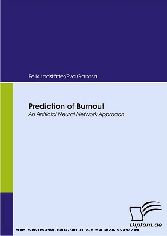Search and Find
Service
Prediction of Burnout An Artificial Neural Network Approach
1
Contents
3
List of Figures
6
List of Tables
9
1 Burnout
12
1.1 The Origin of Burnout
12
1.1.1 The Uncovering of Burnout
13
1.2 Burnout as a Global Problem
14
1.3 Why is Burnout increasing?
15
1.4 Understanding Burnout
18
1.4.1 Definitions
19
1.4.2 Possible Symptoms
21
1.4.3 Burnout vs. Job Stress
24
1.4.4 Burnout vs. Depression
25
1.4.5 Burnout vs. Chronic Fatigue
25
1.5 Assessment and Prevalence
26
1.5.1 Assessment Tools
26
1.5.2 Reliability and Validity
27
1.5.3 Self-report Measures of Burnout
29
1.5.4 How often does Burnout occur?
32
1.6 Correlates, Causes and Consequences
33
1.6.1 Possible Antecedents of Burnout
35
1.6.2 Possible Consequences of Burnout
39
1.7 Theoretical Approaches to Explain Burnout
41
1.7.1 An Integrative Model
42
1.8 Prevention and Intervention of Burnout
44
1.8.1 Classification
44
1.8.2 Individual Level Interventions
46
1.8.3 Individual/Organizational Level Interventions
49
1.8.4 Organizational Level Interventions
53
2 Artificial Neural Networks
57
2.1 Introduction to Neurocomputing
57
2.1.1 Biological Motivation
58
2.1.2 Evolution of Artificial Neural Networks
60
2.1.3 Categorization of Artificial Neural Networks
62
2.2 Artificial Neuron Model
63
2.2.1 Notation and Terminology
63
2.2.2 Single-Input Neuron
64
2.3 Basic Transfer Functions
65
2.3.1 Hard Limit Transfer Function
66
2.3.2 Linear Transfer Function
67
2.3.3 Sigmoid Transfer Function
67
2.3.4 Hyperbolic Tangent Sigmoid Transfer Function
68
2.3.5 Radial Basis Transfer Function (GaussianFunction)
69
2.4 Multiple-Input Neuron
70
2.5 Training Algorithms
71
2.6 Network Architectures
73
2.6.1 A Single Layer of Neurons
73
2.6.2 Multiple Layers of Neurons
74
2.7 Perceptron
76
2.7.1 Perceptron Learning Rule
78
2.7.2 The Perceptron Training Algorithm
79
2.7.3 Limitations of the Perceptron
80
2.8 Self-Organizing Map (SOM)
81
2.8.1 Competitive Learning
82
2.8.2 Kohonen Training Algorithm
88
2.8.3 Example of the Kohonen Algorithm
89
2.8.4 Problems with the Kohonen Algorithm
90
2.9 Multi-layer Feed-forward Networks
92
2.9.1 Hidden-Neurons
94
2.9.2 Back-propagation
95
2.9.3 Back-propagation Training Algorithm
101
2.9.4 Problems with Back-propagation
109
2.10 Radial Basis Function (RBF) Network
117
2.10.1 Functioning of the Radial Basis Network
121
2.10.2 The Pseudo Inverse (PI) RBF TrainingAlgorithm
123
2.10.3 Example of the PI RBF Algorithm
126
2.10.4 The Hybrid RBF Training Algorithm
128
2.10.5 Example of the Hybrid RBF Training Algorithm
134
2.10.6 Problems with Radial Basis Function Networks
138
3 Application of ANNs toBurnout Data
140
3.1 Introduction
141
3.1.1 The Nursing Profession
141
3.1.2 Burnout in Nurses
142
3.1.3 Objective
145
3.2 Data
146
3.2.1 Participants
146
3.2.2 Measures
147
3.2.3 Statistical Data Analysis
148
3.2.4 Variables used for the Development of the ANNs
148
3.3 Implementation of the NuBuNet (NursingBurnout Network)
149
3.3.1 Self-Organizing Map (SOM)
150
3.3.2 Three-layer Feed-forward Back-propagationNetwork
152
3.3.3 Radial Basis Function Network
154
3.4 Processing the Data
155
3.4.1 Data Preparation (Pre-Processing)
155
3.4.2 Network Preparation and Training
158
3.4.3 Post-Processing
162
3.5 Results
162
3.5.1 Three-layer Feed-forward Back-propagationNetwork
163
3.5.2 Radial Basis Function Network (PI Algorithm)
178
3.5.3 Radial Basis Function Network (HybridAlgorithm)
189
3.5.4 Comparison of the Results
207
3.6 Discussion
209
4 References
217
All prices incl. VAT













